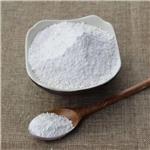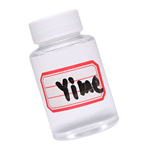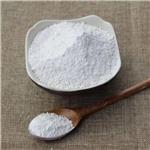- Lactic acid
-

- $4.00 / 1KG
-
2024-04-26
- CAS:50-21-5
- Min. Order: 1KG
- Purity: 99%
- Supply Ability: 20TONS
- Lactic acid
-

- $3.00 / 1KG
-
2024-04-26
- CAS:50-21-5
- Min. Order: 500KG
- Purity: 99%
- Supply Ability: 1000kg
- Lactic acid
-

- $4.00 / 1KG
-
2024-04-25
- CAS:50-21-5
- Min. Order: 1KG
- Purity: 99%
- Supply Ability: 20TONS
|
| | Lactic acid Basic information |
| | Lactic acid Chemical Properties |
| Melting point | 18°C | | alpha | -0.05 º (c= neat 25 ºC) | | Boiling point | 122 °C/15 mmHg (lit.) | | density | 1.209 g/mL at 25 °C (lit.) | | vapor density | 0.62 (vs air) | | vapor pressure | 19 mm of Hg (@ 20°C) | | refractive index | n20/D 1.4262 | | FEMA | 2611 | LACTIC ACID | | Fp | >230 °F | | storage temp. | 2-8°C | | solubility | Miscible with water and with ethanol (96 per cent). | | pka | 3.08(at 100℃) | | form | syrup | | color | Colorless to yellow | | Specific Gravity | 1.209 | | PH | 3.51(1 mM solution);2.96(10 mM solution);2.44(100 mM solution); | | Odor | at 100.00 %. odorless | | Odor Type | odorless | | Water Solubility | SOLUBLE | | Merck | 14,5336 | | JECFA Number | 930 | | BRN | 1209341 | | Dielectric constant | 22.0(16℃) | | Stability: | Stable. Combustible. Incompatible with strong oxidizing agents. | | InChIKey | JVTAAEKCZFNVCJ-UHFFFAOYSA-N | | LogP | -0.72 | | CAS DataBase Reference | 50-21-5(CAS DataBase Reference) | | NIST Chemistry Reference | Propanoic acid, 2-hydroxy-(50-21-5) | | EPA Substance Registry System | Lactic acid (50-21-5) |
| | Lactic acid Usage And Synthesis |
| Description | Lactic acid (2-hydroxypropionic acid, CH3-CHOH-COOH) is the most widely
occurring organic acid in nature. Due to its chiral a-carbon atom, lactic acid (LA)
has two enantiomeric forms. Of these, L-(+)-lactic acid is more important in food and pharmaceutical industries because humans have only L-lactate
dehydrogenase. The chemical behavior of lactic acid is mostly determined
by the two functional groups. Besides the acidic character in aqueous
medium, the bifunctionality (a terminal carboxylic acid and a hydroxyl group)
allows lactic acid molecules to form ‘‘interesters’’ such as the cyclic dimers, the
trimers, or longer lactic acid oligomers.
After its first isolation by the Swedish chemist Scheel in 1780 from sour milk,
lactic acid has been produced commercially since the 1880s in the United States
and later in Europe. Worldwide, lactic acid production was approximately
250,000 metric tons per year in 2012 and is expected to reach 330,000
metric tons by the year 2015, with an average price of 1.25 US$ per
kilogram in 2013 (food grade, 80–85 % purity).
Approximately 85 % of the demand for LA is from the food industry. The
primary use of lactic acid is as a pH-adjusting agent in the beverage sector and as a
preservative in the food industry. It is included in the Generally Recognized as
Safe (GRAS) by the U.S. Food and Drug Administration [158] as a food ingredient
and was deemed safe by the European Food Safety Authority as well [159]. The
acceptable daily intake for LA was defined by the Joint FAO/WHO Expert
Committee on Food Additives as ‘‘not limited,’’ and it is also supported by the
Scientific Committee of Food.
In recent decades, the consumption of lactic acid due to its novel applications
has grown quite rapidly, by 19 % per year. Nonfood use of lactic acid for polymer production contributes to this growth. Biodegradable polylactic acid is
considered to be an environmentally friendly alternative to other plastics from
petroleum. It is used in various fields, including drug delivery systems,
medical devices, fibers, and packaging materials.
Lactic acid can be produced via chemical synthesis or carbohydrate fermentation.
The chemical route has various issues, including toxic raw materials, low
conversion rates, and especially the inability to produce the optically pure isomer.
Therefore, approximately 90 % of lactic acid worldwide is produced by biotechnological
processes, namely fermentations using renewable resources, which
is relatively fast, economical, and able to supply selectively one or two stereoisomers
of lactic acid. | | Chemical Properties | Lactic acid is odorless. It consists of a mixture of lactic acid (C3H6O3) and lactic acid lactate (C6H10O5). The commercial
product is the racemic form. It is usually available in solutions containing 50 to 90% lactic acid. | | Chemical Properties | Lactic acid, CH3CHOHCOOH, also known as 2-hydroxypropanoic acid, is a hygroscopic liquid that exists in three isometric forms. I-lactic acid is found in blood and animal tissue as a product of glucose and glycogen metabolism. d-Iactic acid is obtained by fermentation of sucrose (corn refining), The racemic mixture is present in foods prepared by bacterial fermentation or prepared synthetically. Lactic acid is soluble in water,alcohol,and ether. It is used as a solvent, in manufacturing confectionery, and in medicine. | | Chemical Properties | Lactic acid consists of a mixture of 2-hydroxypropionic acid, its
condensation products, such as lactoyllactic acid and other
polylactic acids, and water. It is usually in the form of the racemate,
(RS)-lactic acid, but in some cases the (S)-(+)-isomer is predominant.
Lactic acid is a practically odorless, colorless or slightly yellowcolored,
viscous, hygroscopic, nonvolatile liquid. | | Chemical Properties | A colorless or yellowish, nearly odorless, syrupy liquid consisting
of a mixture of lactic acid (C3H6O3) and lactic acid lactate
(C6H10O5). It is obtained by the lactic fermentation of sugars or is
prepared synthetically. The commercial product is the racemic
form. It is usually available in solutions containing the equivalent
of from 50% to 90% lactic acid. It is hygroscopic, and when
concentrated by boiling, the acid condenses to form lactic acid
lactate, 2-(lactoyloxy)propanoic acid, which on dilution and heat ing hydrolyzes to lactic acid. It is miscible with water and with
alcohol. | | Occurrence | Reported found in Papaver somniferum L.; it is a constituent of wine and sour milk; the two optically active
isomers are found in muscular tissues and are formed by the action of lactic acid–producing bacteria in several fermentation pro�cesses. Also reported found in guava, grapes, melon, wheat bread, cheeses, yogurt, milk, cream, buttermilk, egg, cooked beef,
cognac, cider, sherry, grape wine, beer, grape brandy, whiskey, cocoa, coffee, tea, mango, sake, wort, dried, bonito, cassava, Bourbon
vanilla, chicory root, Cape gooseberry and cherimoya. | | Uses | Prostaglandin E1 analogue | | Uses | Lactic Acid is an acidulant that is a natural organic acid present in
milk, meat, and beer, but is normally associated with milk. it is a
syrupy liquid available as 50 and 88% aqueous solutions, and is mis-
cible in water and alcohol. it is heat stable, nonvolatile, and has a
smooth, milk acid taste. it functions as a flavor agent, preservative,
and acidity adjuster in foods. it is used in spanish olives to prevent
spoilage and provide flavor, in dry egg powder to improve disper-
sion and whipping properties, in cheese spreads, and in salad dress-
ing mixes. | | Uses | lactic acid (sodium lactate) is a multi-purpose ingredient used as a preservative, exfoliant, moisturizer, and to provide acidity to a formulation. In the body, lactic acid is found in the blood and muscle tissue as a product of the metabolism of glucose and glycogen. It is also a component of the skin’s natural moisturizing factor. Lactic acid has better water intake than glycerin. Studies indicate an ability to increase the water-retention capacity of the stratum corneum. They also show that the pliability of the stratum corneum layer is closely related to the absorption of lactic acid; that is, the greater the amount of absorbed lactic acid, the more pliable the stratum corneum layer. Researchers report that continuous use of preparations formulated with lactic acid in concentrations ranging between 5 and 12 percent provided a mild to moderate improvement in fine wrinkling and promote softer, smoother skin. Its exfoliating properties can help in the process of removing excess pigment from the surface of the skin, as well as improving skin texture and feel. Lactic acid is an alpha hydroxy acid occurring in sour milk and other lesser-known sources, such as beer, pickles, and foods made through a process of bacterial fermentation. It is caustic when applied to the skin in highly concentrated solutions. | | Definition | ChEBI: A 2-hydroxy monocarboxylic acid that is propanoic acid in which one of the alpha-hydrogens is replaced by a hydroxy group. | | Production Methods | Lactic acid is prepared by the fermentation of carbohydrates, such
as glucose, sucrose, and lactose, with Bacillus acidi lacti or related
microorganisms. On a commercial scale, whey, corn starch,
potatoes, or molasses are used as a source of carbohydrate. Lactic
acid may also be prepared synthetically by the reaction between
acetaldehyde and carbon monoxide at 130–200°C under high
pressure, or by the hydrolysis of hexoses with sodium hydroxide.
Lactic acid prepared by the fermentation of sugars is levorotatory;
lactic acid prepared synthetically is racemic. However, lactic
acid prepared by fermentation becomes dextrorotatory on dilution
with water owing to the hydrolysis of (R)-lactic acid lactate to (S)-
lactic acid. | | Biotechnological Production | Lactic acid is produced biotechnologically in general by fermentation of lactic acid
bacteria. More information about this process and new trends are described later in
this chapter. | | Taste threshold values | Taste characteristics at 20 ppm: acidic sour creamy, dairylike with a fruity mango nuance | | General Description | A colorless to yellow odorless syrupy liquid. Corrosive to metals and tissue. Used to make cultured dairy products, as a food preservative, and to make chemicals. | | Air & Water Reactions | Soluble in water. | | Reactivity Profile | Lactic acid is a carboxylic acid. Carboxylic acids donate hydrogen ions if a base is present to accept them. They react in this way with all bases, both organic (for example, the amines) and inorganic. Their reactions with bases, called "neutralizations", are accompanied by the evolution of substantial amounts of heat. Neutralization between an acid and a base produces water plus a salt. Carboxylic acids with six or fewer carbon atoms are freely or moderately soluble in water; those with more than six carbons are slightly soluble in water. Soluble carboxylic acid dissociate to an extent in water to yield hydrogen ions. The pH of solutions of carboxylic acids is therefore less than 7.0. Many insoluble carboxylic acids react rapidly with aqueous solutions containing a chemical base and dissolve as the neutralization generates a soluble salt. Carboxylic acids in aqueous solution and liquid or molten carboxylic acids can react with active metals to form gaseous hydrogen and a metal salt. Such reactions occur in principle for solid carboxylic acids as well, but are slow if the solid acid remains dry. Even "insoluble" carboxylic acids may absorb enough water from the air and dissolve sufficiently in Lactic acid to corrode or dissolve iron, steel, and aluminum parts and containers. Carboxylic acids, like other acids, react with cyanide salts to generate gaseous hydrogen cyanide. The reaction is slower for dry, solid carboxylic acids. Insoluble carboxylic acids react with solutions of cyanides to cause the release of gaseous hydrogen cyanide. Flammable and/or toxic gases and heat are generated by the reaction of carboxylic acids with diazo compounds, dithiocarbamates, isocyanates, mercaptans, nitrides, and sulfides. Carboxylic acids, especially in aqueous solution, also react with sulfites, nitrites, thiosulfates (to give H2S and SO3), dithionites (SO2), to generate flammable and/or toxic gases and heat. Their reaction with carbonates and bicarbonates generates a harmless gas (carbon dioxide) but still heat. Like other organic compounds, carboxylic acids can be oxidized by strong oxidizing agents and reduced by strong reducing agents. These reactions generate heat. A wide variety of products is possible. Like other acids, carboxylic acids may initiate polymerization reactions; like other acids, they often catalyze (increase the rate of) chemical reactions. Slowly corrodes most metals [USCG, 1999]. | | Health Hazard | Inhalation of mist causes coughing and irritation of mucous membranes. Ingestion, even of diluted preparations, has a corrosive effect on the esophagus and stomach. Contact with more concentrated solutions can cause severe burns of skin or eye. | | Fire Hazard | Combustible material: may burn but does not ignite readily. When heated, vapors may form explosive mixtures with air: indoors, outdoors and sewers explosion hazards. Contact with metals may evolve flammable hydrogen gas. Containers may explode when heated. Runoff may pollute waterways. Substance may be transported in a molten form. | | Pharmaceutical Applications | Lactic acid is used in beverages, foods, cosmetics, and pharmaceuticals
as an acidifying agent and acidulant.
In topical formulations, particularly cosmetics, it is used for its
softening and conditioning effect on the skin. Lactic acid may also
be used in the production of biodegradable polymers and microspheres,
such as poly(D-lactic acid), used in drug delivery
systems.
Lactic acid is also used as a food preservative. Therapeutically,
lactic acid is used in injections, in the form of lactate, as a source of
bicarbonate for the treatment of metabolic acidosis; as a spermicidal
agent; in pessaries for the treatment of leukorrhea; in infant feeds;
and in topical formulations for the treatment of warts. | | Industrial uses | lactic acid showed good depressing effect on hornblende, pyroxene and biotite during
flotation of hematite and ilmenite minerals. | | Biochem/physiol Actions | In animals, lactic acid is a metabolic compound produced by proliferating cells and during anaerobic conditions such as strenuous exercise. Lactic acid can be oxidized back to pyruvate or converted to glucose via gluconeogenesis. Lactic acid is preferentially metabolized by neurons in several mammal species and during early brain development. | | Safety | Lactic acid occurs in appreciable quantities in the body as an end
product of the anaerobic metabolism of carbohydrates and, while
harmful in the concentrated form , can be
considered nontoxic at the levels at which it is used as an excipient.
A 1% v/v solution, for example, is harmless when applied to the
skin.
There is evidence that neonates have difficulty in metabolizing
(R)-lactic acid, and this isomer and the racemate should therefore
not be used in foods intended for infants aged less than 3 months
old.
There is no evidence that lactic acid is carcinogenic, teratogenic,
or mutagenic.
LD50 (guinea pig, oral): 1.81 g/kg
LD50 (mouse, oral): 4.88 g/kg
LD50 (mouse, SC): 4.5 g/kg
LD50 (rat, oral): 3.73 g/kg | | storage | Lactic acid is hygroscopic and will form condensation products
such as polylactic acids on contact with water. The equilibrium
between the polylactic acids and lactic acid is dependent on
concentration and temperature. At elevated temperatures lactic acid
will form lactide, which is readily hydrolyzed back to lactic acid.
Lactic acid should be stored in a well-closed container in a cool,
dry place. | | Incompatibilities | Incompatible with oxidizing agents, iodides, and albumin. Reacts
violently with hydrofluoric acid and nitric acid. | | Regulatory Status | GRAS listed. Accepted for use as a food additive in Europe.
Included in the FDA Inactive Ingredients Database (IM, IV, and SC
injections; oral syrups and tablets; topical and vaginal preparations).
Included in medicines licensed in the UK. Included in the
Canadian List of Acceptable Non-medicinal Ingredients. |
| | Lactic acid Preparation Products And Raw materials |
|